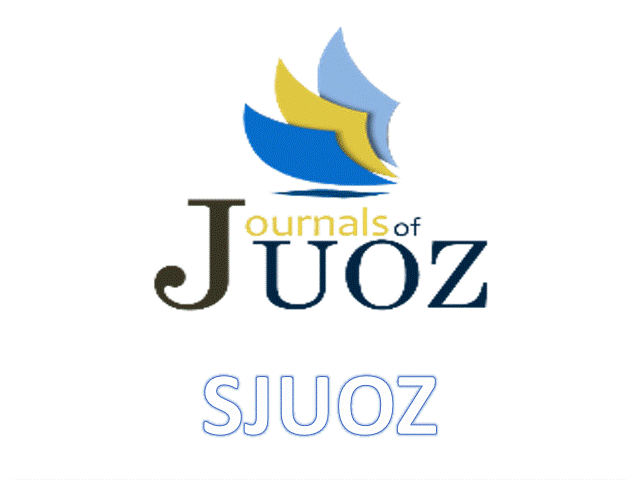Antimicrobial Susceptibility Pattern of Pathogenic Bacteria Causing Urinary Tract Infections at Azadi Hospital In Duhok City\Kurdistan Region of Iraq
DOI:
https://doi.org/10.25271/2018.6.2.435Keywords:
Antimicrobial, Urinary Tract Infections, Susceptibility, IraqAbstract
Urinary tract infections represents one of the most common diseases encountered in medical practice affecting people of all ages from the neonate to the geriatric age group. The aim of this study was to determine and evaluate the antimicrobial susceptibility patterns for most common strains of bacterial urine isolates taken from patients at Azadi teaching hospital laboratories in Duhok city/Kurdistan region in Iraq, for two years (2014 and 2015). A retrospective survey study was conducted and 1003 data of urine culture sensitivity test were collected from recorded archives of the Azadi hospital of two years; 2014 and 2015. The study included all recorded positive urine samples cultures isolated from inpatients and outpatients. Results revealed that the female to male ratio for urinary tract infection was 2.7:1 and the most common microorganisms isolated were Escherichia coli (52%), Staphylococcus aureus (11%), Staphylococcus haemolyticus (9.6%) and Klebsiella pneumoniae (8.1%). In general maximum sensitivity was seen for Meropenem (94.9%), followed by Imipenem (89.7%) and Ertapenem (88.7%). The maximum resistance was seen against Cefazolin (79.7%) and Amoxicillin/clavulanic acid (77.5%). The antibiotic sensitivity pattern of E. coli reveals that the maximum sensitivity was seen for Meropenem (97.3%) and Imipenem (95.6%). The maximum resistance was seen against Amoxicillin/clavlanic acid (83.1%). The resistance against many commonly used antibiotics have been increased which limit the options for treating urinary tract infection. This is resulted from uncontrolled use of the antibiotics and lack of policies and guidelines for their use in public health.
Downloads
References
Al-Barzinji, R.; Esmahil, S.; Sulaiman, S. and Raheem, S.G. (2010). Effect of some antimicrobial agents on isolated bacteria from patients with urinary tract infection in Kurdistan Region. Zanco J Med Sci, 14.
Al-Jebouri, M.M. and Mdish, S.A. (2013). Antibiotic Resistance Pattern of Bacteria Isolated from Patients of Urinary Tract Infections in Iraq. . Open J of Urology, 3: 124-131.
Assafi, M.S.; Ibrahim, N.M.R.; Hussein, N.R.; Taha, A.A. and Balatay, A.A. (2015). Urinary Bacterial Profile and Antibiotic Susceptibility Pattern among Patients with Urinary Tract Infection in Duhok City, Kurdistan Region, Iraq. Int. J. Pure Appl. Sci. Technol., 30: 54-63.
Assafi, M.S.; Mohammed, R.Q. and Hussein, N.R. (2015). Nasal carriage rates of Staphylococcus aureus and ca-methicillin resistant Staphylococcus aureus among university students. Int. J. Microbiol. Res., 5: 123-127.
Assafi, M.S.; Polse, R.F.; Hussein, N.R.; Haji, A.H. and Issa, A.R. (2017). The Prevalence of S. aureus Nasal Colonisation and its Antibiotic Sensitivity Pattern amongst Primary School Pupils. Science Journal of University of Zakho, 5: 7-10.
Carlet, J.; Collignon, P.; Goldmann, D.; Goossens, H.; Gyssens, I.C.; Harbarth, S.,Voss, A. (2011). Society's failure to protect a precious resource: antibiotics. Lancet, 378: 369-371.
Foxman, B. (2010). The epidemiology of urinary tract infection. Nat Rev Urol, 7: 653-660.
Gupta, K.; Hooton, T.M. and Stamm, W.E. (2001). Increasing antimicrobial resistance and the management of uncomplicated community-acquired urinary tract infections. Ann Intern Med, 135: 41-50.
Habeeb, A.; Hussein, N.R.; Assafi, M.S. and Al-Dabbagh, S.A. (2014). Methicillin resistant Staphylococcus aureus nasal colonization among secondary school students at Duhok City-Iraq. J Microbiol Infect Dis, 4: 59-63.
Hussein, N.R.; Assafi, M.S. and Ijaz, T. (2017). Methicillin-resistant Staphylococcus aureus nasal colonisation amongst healthcare workers in Kurdistan Region, Iraq. J Glob Antimicrob Resist, 9: 78-81.
Hussein, N.S. (2014). Clinical, Etiology and Antibiotic Susceptibility Profiles of Community-Acquired Urinary Tract Infection in a Baghdad Hospital Med Surg Urol, 3: 1-5.
Jasovsky, D.; Littmann, J.; Zorzet, A. and Cars, O. (2016). Antimicrobial resistance-a threat to the world's sustainable development. Ups J Med Sci, 121: 159-164.
Kayaş, L.; Yolbaş, I.; Ece, A.; Kayaş, Y.; Balık, H. and Kocamaz, H. (2011). Causative agents and antibiotic susceptibilities in children with urinary tract infection. JMID, 1: 17-21.
Kiffer, C.R.; Kuti, J.L.; Eagye, K.J.; Mendes, C. and Nicolau, D.P. (2006). Pharmacodynamic profiling of imipenem, meropenem and ertapenem against clinical isolates of extended-spectrum beta-lactamase-producing Escherichia coli and Klebsiella spp. from Brazil. Int J Antimicrob Agents, 28: 340-344.
Lin, C.H. (2014). Urinary Tract Infection. Pages 794-809. A Clinical Approach to Medicine, WORLD SCIENTIFIC.
Mahmood, M.A. (2011). Prevalence and Antimicrobial Susceptibility of Pathogens in Urinary Tract Infections. J of Al-Nahrain University, 14: 146-152.
Maki, D.G. and Tambyah, P.A. (2001). Engineering out the risk for infection with urinary catheters. Emerg Infect Dis, 7: 342-347.
Polse, R.F.; Yousif, S.Y. and Assafi, M.S. (2016). Prevalence and antimicrobial susceptibility patterns of uropathogenic E. coli among people in Zakho, Iraq. Int. J. Res. Med. Sci., 4: 1219-1223.
Polse, R.F.; Yousif, S.Y. and Assafi, M.S (2016). Prevalence and molecular characterization of extended spectrum beta-Lactamases-producing uropathogenic Escherichia coli isolated in Zakho, Iraq. Journal of Microbiology and Infectious Diseases, 6: 163-167.
Ruden, H.; Gastmeier, P.; Daschner, F.D. and Schumacher, M. (1997). Nosocomial and community-acquired infections in Germany. Summary of the results of the First National Prevalence Study (NIDEP). Infection, 25: 199-202.
Saeed, C.H.; AL-Otraqchi, B. and Mansoor, I.Y. (2015). Prevalence of urinary tract infections and antibiotics susceptibility pattern among infants and young children in Erbil city. Zanco J Med Sci, 19: 915-922.
Saffar, M.J.; Enayti, A.A.; Abdolla, I.A.; Razai, M.S. and Saffar, H. (2008). Antibacterial susceptibility of uropathogens in 3 hospitals, Sari, Islamic Republic of Iran, 2002-2003. East Mediterr Health J, 14: 556-563.
Yassin, N.A. (2012). Laboratory evaluation of urine culture and drug resistance in outpatients clincally suspected of urinary tract infections. Rawal Medical J, 37: 268-272.
Downloads
Published
How to Cite
Issue
Section
License
Copyright (c) 2018 Ibtesam S. Abdulrahman

This work is licensed under a Creative Commons Attribution 4.0 International License.
Authors who publish with this journal agree to the following terms:
- Authors retain copyright and grant the journal right of first publication with the work simultaneously licensed under a Creative Commons Attribution License [CC BY-NC-SA 4.0] that allows others to share the work with an acknowledgment of the work's authorship and initial publication in this journal.
- Authors are able to enter into separate, additional contractual arrangements for the non-exclusive distribution of the journal's published version of the work, with an acknowledgment of its initial publication in this journal.
- Authors are permitted and encouraged to post their work online.








